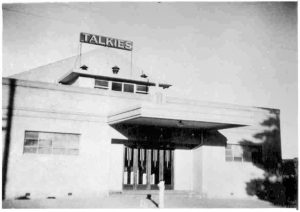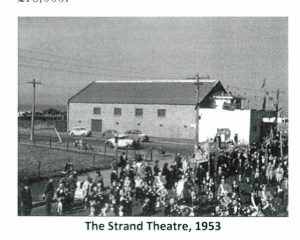The Strand Theatre, Altona (cnr Pier and Queen Streets)
In the ten or so years following World War 1, Altona began to grow out of its small bayside village to feel like an emerging suburb. By 1926, the railway had been electrified, so electricity was now beginning to spread to houses and businesses too. With this and the promise of reticulated water supply, growth in activity, business, and population prospered. With growth came entrepreneurs and one such person was John Francis O’Brien. At this stage, whilst there were several halls built within the town, including one on the corner of Pier Street and the Esplanade, some have stated that no picture shows had taken place in Altona, to this date, but others believe that a couple of picture shows took place within the St Mary’s hall.
In July 1927, John O’Brien changed all of this when he gained approval from the Public Works Department[i]. John put out a tender[ii] for the erection of a purpose-built picture theatre, which was excepted by Architects and Engineers, V G Cook. The tender sort for the design and building of a small brick theatre. It didn’t take the firm very long at all to design the theatre and get construction underway. By August, it was already being reported that the “new and up-to-date brick picture theatre is nearing completion in Pier Street, Altona and will be open before the summer trade commences.”[iii]
 The theatre opened on 24 September 1927, with John O’Brien noted as the proprietor and Charles Benn as the Manager. In October of that year, it was stated that “the value of buildings erected within the Shire of Werribee during past 12 months is approximately £32,500. This includes one picture theatre at Altona, at a cost of £18,000.”[iv]
The theatre opened on 24 September 1927, with John O’Brien noted as the proprietor and Charles Benn as the Manager. In October of that year, it was stated that “the value of buildings erected within the Shire of Werribee during past 12 months is approximately £32,500. This includes one picture theatre at Altona, at a cost of £18,000.”[iv]
John O’Brien was not just an influential businessman in Altona. He also saw a need and opportunity to influence the progress of the town. He quickly threw his name into the political ring by standing for the election to represent the new Altona Riding of the Werribee Shire council, being elected alongside Charles Cherry and David Grieve. The Strand Theatre often became the venue for various community organisations, including the Altona Traders Association and Altona Community Hospital. By 1934, the theatre was upgraded and altered to accommodate ‘sound’ equipment to enable the showing of ‘talkies’ as they were then known as.
In 1938, The Film Weekly listed the Altona theatre as being a Mechanics’ Institute for John O’Brien and seating 400.[v] This is the only year it is recorded like this. Les Tod, in his article within CinemaRecord #105[vi], notes that he could find no record of a Mechanics’ Institute in Altona within any database. He believes this is an error made within The Film Weekly entry which has been perpetuated by others.
In 1937, John Francis O’Brien passed away and the ownership pf the theatre passed onto George Alfred and Rosa June Kirby.[vii] George Kirby was the father of Roc Kirby, who later founded the Village Roadshow company. The couple also owned the Roxby Theatre on Ballarat Road, Maidstone, and another in Bacchus Marsh[viii]. In December 1939, it was reported that he and his wife hosted a Christmas party for the combined staff of all their theatres By this time, the seating capacity at The Strand had also increased to 480 patrons.
In April 1947, the Werribee Council threatened to closure the theatre due to the state of its conveniences. This issue dragged on for some time as George Kirby resisted the expense required to put in new toilets and the council not relenting with their request to put things right to their specifications.[ix] The issue was still controversial in October that year when it was stated that the Council’s patience had been tried, and despite meetings, nothing had been done. Finally, the Council resolved to ask the proprietor to submit plans for proper conveniences within a month or the theatre would be closed.[x] Also, by this time, the ownership of the theatre appeared to possibly be in the name of Rosa June Kirby, George’s wife, where it remained so until around 1953 when a further internal transfer of ownership occurred.
In September 1949, it was announced that Mr George Kirby, “the enterprising head of Kirby’s Theatres, has added another link to his chain of picture theatres by the acquisition of the theatre in one of Victoria’s most popular seaside holiday resorts.” However, whilst the name the name of the theatre and town were omitted, we believe it was the Athenaeum Theatre in Sorrento.[xi] [xii]
By June 1950, the Altona Theatre was once again in trouble with the authorities, this time for not following public health regulations. On this occasion, an employee named Mr R Williams was fined £22/2/- (including costs) for not keeping films in a fireproof container and failing to have an exit notice displayed. The proprietor, George Kirby, was fined £12/2/- (including costs) too for having prohibited fastenings on the theatre doors and a further £2 for failing to have exit doors that opened freely.[xiii]
 The Strand Theatre suffered a serious fire on the afternoon of 1 July 1954, which was reported to have damaged the theatre to the value of £4,500. Within the same article, it was reported that they had hoped to have the theatre opened again that very evening.[xiv] However, another newspaper reported that three firemen narrowly escaped from falling material in the Strand Theatre fire. It was said that heavy chandeliers and plaster sheeting fell from the ceiling to the stalls and that the theatre screen, amplifier, and a large section of the stage and back wall had been destroyed.[xv]
The Strand Theatre suffered a serious fire on the afternoon of 1 July 1954, which was reported to have damaged the theatre to the value of £4,500. Within the same article, it was reported that they had hoped to have the theatre opened again that very evening.[xiv] However, another newspaper reported that three firemen narrowly escaped from falling material in the Strand Theatre fire. It was said that heavy chandeliers and plaster sheeting fell from the ceiling to the stalls and that the theatre screen, amplifier, and a large section of the stage and back wall had been destroyed.[xv]
The Film Weekly reported that the stage, screen, and equipment had been destroyed, and that a temporary screen had been erected. The fire was said to have been caused by a cigarette butt.[xvi] The following year, the theatre was again upgraded after its extensive repairs with the installation of ‘CinemaScope’.
The Strand Theatre continued to operate under Kirby’s Theatres until it closed in 1959. By 1963, it had been demolished and replaced by retail shops. Additionally, television was now also on the scene, which people and families were spending more time watching rather than going out to the cinema.
The Altona-Laverton Historical Society wishes to acknowledge the contribution from the Cinema and Theatre Historical Society of Vic, and their researcher Les Tod.
[i] Werribee Shire Banner, Thursday 21 July 1927 p2
[ii] The Argus, Saturday 4 June 1927 p21
[iii] Williamstown Chronicle, Saturday 20 August 1927 p2
[iv] Werribee Shire Banner, Thursday 20 October 1927 p5
[v] The Film Weekly Motion Picture Directories, 1937-71
[vi] CinemaRecord Issue 105, Cinema and Theatre Historical Society of Vic p37
[vii] Leongathahistory.org.au, Newsletter Vol 17 No. 9 dated November 2020, accessed July 2022
[viii] Sunshine Advocate, Friday 22 December 1939 p6
Williamstown Chronicle, Thursday 24 April 1947 p11
[x] Ibid. Friday 17 October 1947 p7
[xi] Sunshine Advocate, Friday 23 September 1949 p1
[xii] Sunshinebaseball.com.au, accessed July 2022
[xiii] Williamstown Chronicle, Friday 16 June 1950 p7
[xiv] The Argus, Friday 2 July 1954 p3
[xv] Barrier Miner, Broken Hill, Saturday 3 July 1954 p3
[xvi] The Film Weekly, 8 July 1954.
Research: Graeme Reilly (ALHS) 2022
Edited: Adam Virgona 2022
